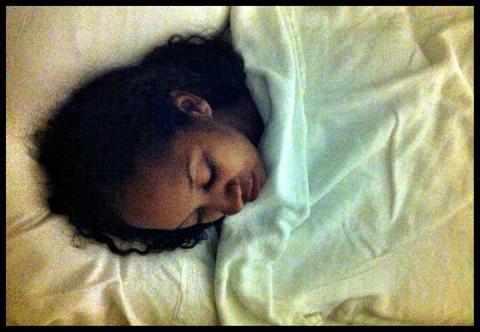
‘I was young, I was in good health, I didn’t smoke and I exercised regularly.’ And yet: the author after her stroke, in a picture taken by her husband, photographer Sean McNeil.
5:20 a.m., ICU
Sean fills the basin with hot water and places it nearby. He’s still bleary with sleep and questioning my sanity, my need to do this—now. He brings the comb he picked up on his way in one night and the conditioner we use at home, and that’s what it smells like. Home.
Slowly, painstakingly, he wets each tendril of hair and lathers it with conditioner. I feel flattered and helpless. Inch by inch, ends to scalp, I comb the tangles. It hurts. And it takes a long time.
When I’m done, he combs it all back and watches me maneuver a ponytail despite the tubes in my arm. I think the doctors won’t recognize me. Maybe a nurse will say, “You have such pretty hair.” I feel somewhat restored, a little less in crisis. “I love you,” Sean says. And I smile tiredly through the pain.
I hadn’t combed my hair in three days.
And on a basic level that mattered. But after being shipped from one hospital to another, one room, one machine to another, it mattered less.
It was tangled, messy, sticking up in strange places. I barely recognized it as my own; I barely recognized me as myself.
It reminded me of my own helplessness.
Every morning, they came for blood. I called the nurse and asked for a bedpan when I needed it.
Oh, and my dignity, bring that, too. Dignity and a comb. And a doctor’s order with permission for a shower. Supervised shower? I’ll take it.
When I went to bed on Nov. 27, 2011, my biggest problem was coming down from the weekend and facing work on Monday. When I woke up in the morning, the bottom fell out.
That day and for the next eight days, I functioned with the most terrible headache imaginable, waiting for the pain to pass, wondering why over-the-counter, extra strength pills weren’t working.
It got progressively worse: dizziness, inarticulateness, looking at words and not being able to read, as if they were written in a foreign language.
I was not used to being a foreigner among words.
That’s when real concern set in. Ordinary headache it was not.
At the doctor’s office, the nurse practitioner fired off questions and frowned with concern when we talked about my symptoms.
“We need to get you to the ER,” she said. “It might be nothing, but it could be something and we need to find out.”
In the ER, the nurse asked me my name, if I knew where I was, what month it was. I couldn’t remember. It was December.
After the MRI, a gray-haired doctor came in. There was bleeding on the left side of my brain and a clot the size of a small egg behind my ear. I looked in wonder at the scan he held up.
A stroke at 29? I guess it was something after all.
The nurse gave me morphine and ice chips while I waited for an ambulance to EVAC me to a hospital with a neurology unit.
“You’re taking this so well,” the EMT in the ambulance said. “What else can I do?” I asked, watching fascinated as I twirled my feet in circles beneath the blanket on the gurney.
Shock does that.
A stroke occurs when a blood vessel that carries oxygen and nutrients to the brain is either blocked by a clot or bursts (or ruptures). When that happens, part of the brain cannot get the blood (and oxygen) it needs, so it and brain cells die. – American Stroke Association.
An ischemic stroke, the one I had, can be caused by a clot obstructing the flow of blood to the brain. A hemorrhagic stroke happens when a blood vessel ruptures and prevents blood flow to the brain.
A TIA or transient ischemic attack, also called a “mini stroke”, is caused by a temporary clot.
The vast majority of strokes occur in people over age 65, but 10 percent to 15 percent affect people age 45 and younger, this study found. Strokes in the “young” are less common, so they’re more likely to be misdiagnosed and chalked up to vertigo, migraine, and intoxication, among other issues. Because of that, proper treatment isn’t always immediately put in place.
After 48 to 72 hours, there aren’t any major interventions available to improve stroke outcome.
I was young, I was in good health, I didn’t smoke and I exercised regularly. In fact, I’d been training for a half-marathon when the brain hemorrhage happened. I ran through the pain, invincible, until I showed up at the ER.
I was lucky. My doctor’s nurse practitioner recognized the signs and sent me to the hospital. The doctor there did an MRI and spotted the clot.
If you think you have symptoms, don’t do what I did. Despite the signs, I didn’t know and I waited much longer than 72 hours to seek help. That I could walk and talk, then and now, is quite frankly, a miracle.
In the ICU of the new hospital, they came every hour to make sure I was functioning, that my eyes dilated, that I could squeeze their fingers and push back on their hands with my feet.
One nurse had me read through flip cards; another did ultrasounds on my heart and the blood vessels in my neck. The things they do when you have a stroke. CT scan. MRI. Questions. Every hour. Would there be surgery?
My brothers flew in. Eighteen hundred miles away, my parents agonized long distance. A revolving door of concerned friends and family commenced.
Seven days later, I was discharged.
The pain was still ever present, but tolerable and fading. Some words were still hard to find in conversation. Sometimes I got dizzy; I was exhausted, tired of the hospital and being sick. I needed sleep and familiar things.
The clot would shrink and the blood would dissipate, but I wouldn’t get confirmation for another three years from another neurologist that the cause was my birth control shot.
Hormonal contraceptives nearly double women’s risk of stroke and we die from it at a much higher rate than men. We account for 60 percent of all stroke deaths, the AHA says. Read and believe the fine print, ladies. It’s real and it happens.
By no means am I anti-birth control. I believe in every woman’s right to choose. But I also strongly believe that we must ask questions, we must talk about our options with trusted health care professionals and understand the risks before deciding what kind of birth control we want or if we want it at all. Information is power.
In the months after my discharge, at home, on the couch or in bed, I did a lot of sleeping enforced by my healing brain.
I did a lot of thinking and a lot of feeling.
I couldn’t drive, exercise or lift heavy objects, walking the dog left me dizzy and panting. It was frightening, frustrating, humiliating and humbling to be so fully dependent on others, especially for a fiercely independent woman like me.
Life never seemed so short; time and possibility and gratitude had never stretched out so far beyond me.
It was and is one of those crisis reminders that shakes you out of a complacent life. For me, it became about how could I accomplish the things I wanted to do, the things that made me happy, and how I could find a place professionally and personally that would take me there.
Days like World Stroke Day today, established by the World Stroke Organization to help spread public awareness of stroke risk and prevalence, are my annual reminder to be grateful, to take stock, and to share my experience, no matter how vulnerable it has left me.It’s why I wear yellow.
Almost three years later, Sean—the man who slept on an ICU recliner every night not knowing if his fiancée would still be the woman he proposed to two weeks before—and I are married, we have a beautiful daughter, and I have a drive-me-batshit-crazy-stressful-news-junkie job I love.
The effects are still there. Sometimes I forget words or what I’m saying in the middle of a conversation, or where the glasses go, or where I’m going. I function around it and despite it. Most people don’t even know. But life for me will always be Kari Before The Stroke and Kari After The Stroke, in so many ways.
The improbable is now possible, whether it means failure, death or successes, even the small ones.
To learn more about how to recognize a stroke please visit The Stroke Association and help bring awareness to World Stroke Day
This piece first appeared in The Well Written Woman on October 29, 2014.



The views and opinions expressed in this post are those of the author(s) and do not necessarily reflect those of MomsRising.org.
MomsRising.org strongly encourages our readers to post comments in response to blog posts. We value diversity of opinions and perspectives. Our goals for this space are to be educational, thought-provoking, and respectful. So we actively moderate comments and we reserve the right to edit or remove comments that undermine these goals. Thanks!